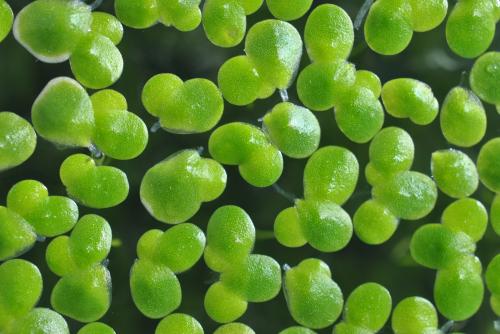Technologies Available for License
Category: biotechnology & health
2014-026: Transformation of Duckweed
Invention: 2014-045
Patent Status: U.S. Patent Number 9,957,514 was issued on May 1, 2018
For technical and licensing related questions, email tcp@bnl.gov.
Summary

Microscope image of duckweed shows the frond structure, with each frond measuring approximately three millimeters across.
Lemnaceae plants also known as Duckweed are attractive options as biofuel feedstocks because of their robust growth in marginal aquatic environments and excellent metabolic characteristics. The current invention by researchers from Brookhaven National Laboratory and Cold Spring Harbor Laboratory describes a method to stably transform Duckweed to overexpress any protein of interest.
Description
In brief the method includes the following steps: (a) inoculating, in liquid infection medium with actively growing duckweed callus with an engineered Agrobacterium that comprises a nucleic acid of interest, a selectable marker gene, and visible reporter gene (b) culturing the inoculated callus from step a on semi-solid nodule production medium that contains a selection substance and antibiotic (c) selecting, from cultured, inoculated callus of (b), transformed callus that expresses the visible reporter gene, (d) culturing, in liquid selection medium that comprises the selection substance and the antibiotic, selected callus of (c), and (e) culturing callus cultured in (d) on semi-solid medium, thereby producing genetically engineered progeny duckweed containing the nucleic acid of interest. In some embodiments, the semi-solid medium of (d) is semi solid selection medium that comprises the selection substance and the antibiotic.
Benefits
The method of transformation described in the invention allows one to duckweed transformants that over express different categories of genes, including various enzymes and transcription factors that enhance oil production. It has been shown Lemnaceae under optimal conditions have an exponential growth rate and can produce 64 grams of biomass per gram of starting weight in a week, which is far beyond the fastest growing corn rates (2.3 g/g/week) and does not have secondary products such as lignin.
Applications and Industries
Duckweed are an attractive option as biofuel feedstocks because of their robust growth in marginal aquatic environments and excellent metabolic characteristics.
Journal Publication & Intellectual Property
Tags: fatty acid
Contacts
-

Poornima Upadhya
Manager Technology Transfer & Commercialization
Technology Commercialization
(631) 344-4711, pupadhya@bnl.gov
-

Avijit Sen
IP Licensing & Commercialization
Technology Commercialization
(631) 344-3752, asen@bnl.gov




